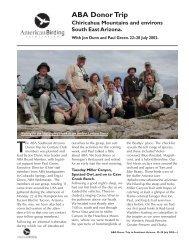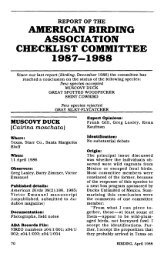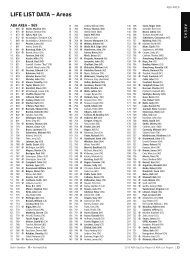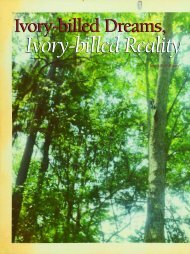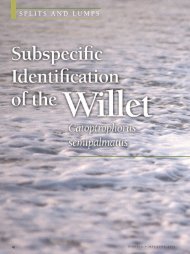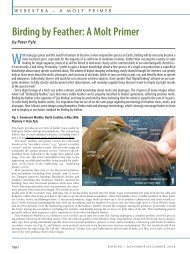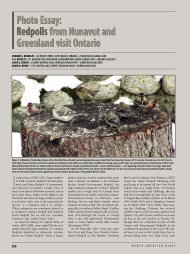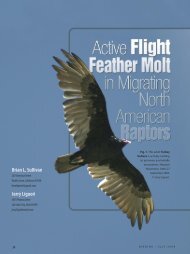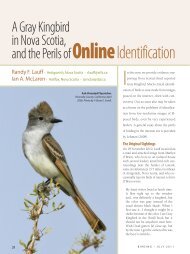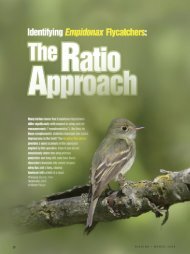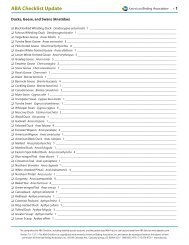2011 ABA Big Day & List Report - ABA Listing Central - American ...
2011 ABA Big Day & List Report - ABA Listing Central - American ...
2011 ABA Big Day & List Report - ABA Listing Central - American ...
- No tags were found...
Create successful ePaper yourself
Turn your PDF publications into a flip-book with our unique Google optimized e-Paper software.
a route and setting a schedule than actually nailing birds down, but better conditionswould have helped. Highlights for the day included 2 White-winged Scoters at KehewinLake, numerous Sabine’s Gulls lingering at Cold Lake, a flock of White-winged Crossbillsalong Primrose Lake Rd and a nice little group of peeps near Bonnyville. We had reallyonly given ourselves one day for the attempt so we could only hope weather would cooperatetomorrow. The afternoon was very windy and as the wind howled when wewent to bed, we prayed that the forecast would deliver and tomorrow would be a cool,calm morning. An attempt to get a solid night’s sleep that evening around 8pm provedto be insufficient as we planned to be on the road for 00:00 hours.June 4, <strong>2011</strong> (the <strong>Big</strong> <strong>Day</strong>). The prolonged and cold north winds had died down in theevening but the effect would cripple us regardless. Temperatures had dropped wellbelow zero with the coldest part of the morning a chilling -6 degrees Celsius! As onecan imagine, neotropical warblers do not enjoy temperatures this low and we would endup spending more time in the boreal than our schedule had allotted for. Fortunately thewind was nearly absent and our combined hearing efforts enabled us to track downmost of the boreal targets in small numbers. Our efforts began with owling and a disappointingmiss was a scouted Great Horned Owl first thing near the Cold Lake townsite. We managed to find a Northern Saw-whet Owl at the Provincial Park, Barred Owlsat numerous stops and most notable of all was a hooting Great Gray Owl along PrimroseLake Road at first light. We also located all three species of rail, Sedge Wren andof course Nelson’s Sparrow during the pre-dawn hours.As our list grew, we noticed the impact the cold was having with far less vocal activitythan we were accustomed to for the area. Nevertheless we scored most of the warblersincluding Nashville and Palm warbler. Another somewhat unexpected highlight wasa male Black-backed Woodpecker near English Bay which is the more elusive of the threetoedwoodpeckers in the region. We scoped the lake and added Red-breasted Merganser,Western Grebe and a Pacific Loon but failed to find the Sabine’s of the previous evening.One last scan from the Provincial Park and a flock of Franklin’s carried one, then 2, thenat least 4 Sabine’s Gulls in it! Shorebirds in the area were more or less a bust and the coldmust have been too much for Common Nighthawk which we would not get for the day.We were behind schedule as we left the boreal towards our parkland stop but decidedthat we could cut out some stops further down the route. During a construction stop parallelto Kehewin Lake we searched for our scouted White-winged Scoters when a surprisepair of Surf Scoter flew by. We also added Great Crested Flycatcher and Philadelphia Vireo,but searched in vain for Broad-winged Hawk and Turkey Vulture, both of which were probablytoo cold to soar this morning. We began our long trek south and eventually addeda single Turkey Vulture among the numerous drive by additions. The biggest highlight ofthe long prairie drive was a Richardsonii Merlin—a notorious miss on big days.Just before descending into the Red Deer River valley we noticed a Golden Eaglebeing mobbed by a Short-eared Owl! We all conceded that it would be hard to top arare interaction such as that today. We continued on to our badlands stop where all theexpected were finally tallied along with some surprises. Our only Blackpoll Warbler ofthe trip was a nice bonus but we didn’t expect to get both Olive-sided and Yellow-belliedFlycatchers after we missed them up north. What a huge relief!! We were far behindschedule at this point and needed many more prairie species to go. A drive by alake near Brooks provided a Caspian Tern which we did not expect to get. The town ofTilley provided Eurasian Collared-Dove among the houses and a female Bobolink in theoutskirts of town. At our prairie spot we listened for Baird’s Sparrow and pulled out asurprise Grasshopper Sparrow in the process. We tried not to linger as we continuedsouthwest but stopped at a few sloughs adding Black-bellied Plover and Stilt Sandpiper.Despite being 4 days into June, it was apparent that migration was still goingstrong in the province. A woodlot south of Brooks had numerous Swainson’s and aGray-cheeked thrush among the scattered neotropical migrants. The biggest shockerwas a Broad-winged Hawk perched in a tree near Taber, far from the expected range,and a species we had given up on after missing in the parkland.We had ever diminishing daylight left as we approached the epic scenic entrance toWaterton Lakes National Park. Every species was critical at this point. We quickly foundMacGillivray’s Warbler and Dusky Flycatcher although a few other locals eluded us. Barrow’sGoldeneye, Rufous and Calliope hummingbird, <strong>American</strong> Dipper and Cassin’s Finchwere among the new additions near the town site. We nearly drove past a male DuskyGrouse during our ascent to higher elevations. Townsend’s Warbler, Pacific Wren andWhite-winged Crossbill were added along Cameron Lake road as the light finally died.The chiming of Varied Thrushes in the valley would be one of our last species. With whatlittle energy we had left, we checked the river with flashlights hoping for a HarlequinDuck without success. All said it was a respectable effort with numerous surprises alongthe way. Most shocking perhaps was the evident migration we encountered at such alate date. We completed the day with 210 species and irrefutably the best single day ofbirding any of us experienced yet. This was one for the books that will last a while.BRITISH COLUMBIA #1 – 18 May <strong>2011</strong> – 0000 to 2230 – Species totals: 202/196.(Team/shared). Russell C. Cannings (200), Peter Davidson (200), Nathan Hentze (199).Kilometers by Car: 850 km. Kilometers by Foot: 1 km. Visiting: Kelowna, Max Lake,Vaseux Lake, Shuttleworth Creek, Road 22, White Rock, Blackie Spit, Boundary Bay,Tsawwassen, Iona Island. Species of Note: Snow Goose (LS), Cackling Goose (LS), BlackScoter (LS), Solitary Sandpiper (L), Red Knot (L), Sanderling (L), Parasitic Jaeger (LS),Least Flycatcher (E).Comments: This sets a new record for a British Columbia<strong>Big</strong> <strong>Day</strong>, the previous record held by Russell Cannings and others (197) set in 2010.This was the Pacific coastal half of the Baillie Birdathon Bi-Coastal Challenge to raisemoney for bird conservation in Canada.When I was asked to be one of the two guest birders for the “Bi-Coastal” version ofthe Baillie Birdathon this year I spent a few seconds deciding on my strategy. The overallgoal was to maximize the number of combined species between my Birdathon inBritish Columbia and Blake Maybank’s in Nova Scotia. Should I concentrate only onwestern species that Blake couldn’t find out east, or should I just try to see as many differentbirds as possible? I knew right away that I would use the latter approach, especiallysince my son Russell had recently beaten my one-day record for the number of birdspecies seen in one day in British Columbia. Last year Russell had put together a teamthat found 197 species in one day, one more than my record set in 1995 (coincidentally,one of my team members in 1995 was Blake Maybank). So, in the interest of familyunity, I asked Russell if he’d like to be on my team this year. He instantly said yes, andafter a bit of planning we decided to add two coast-based birders, Pete Davidson andNathan Hentze. Our simple goal—200 species in one day.Midnight on May 18th found the four of us huddled in my car on a back road in thefarmlands north of Kelowna. The stars were all aligned for a good day—after weeks ofcold rain, the weather forecast was for clear skies and calm winds. An almost-full moonrose over the barn behind us—that might be a great help in finding songbirds beforedawn. And with the full moon came a huge high tide that would be waiting for us whenwe reached the Fraser Delta later in the day—forcing ducks and shorebirds off the distantmudflats and into view. On top of that, Russell, Pete and Nathan had been busyscouting the route for difficult species and had a long list of sites where we could findsome great birds.My watch alarm went off and we coasted down the road towards our first stake-out.Russell shone the flashlight up into an elm and onto a large stick nest where a Swainson’sHawk had been sitting a couple of days ago. The nest was empty! Our hearts sankas we realized the bird must have just been holding the nest during the day before layingeggs and was probably roosting in another tree nearby. Not a good way to start, butit was only one species missed, so we kept our hopes up and drove to Robert Lake. Herewe knew we’d find a nice variety of birds roosting close to the road, and this time wewere not disappointed. A cluster of black-and-white on the shore became 5 handsome<strong>American</strong> Avocets in the binoculars—a species we wouldn’t see anywhere else alongour route, and a Wilson’s Phalarope calling in the darkness was another bird that couldbe difficult to find.Heartened, we turned south and drove to Penticton to start some serious owling. Russellspotted a Great Horned Owl on a wire just north of Penticton, but the rest of us hadto wait until our next stop to hear one. We bounced up the rough road past Max Lake andinto the narrow valley famous for its Common Poorwills and Flammulated Owls. As wehopped out, the poorwills were calling everywhere (another bonus from the full moon!)but the distant hoots of a lone Flammulated took us a bit longer to hear. Virginia Rails andSoras called from the marsh and we were on our way again. By 2:15 a.m. we were at aNorthern Saw-whet Owl nest along White Lake Road, where we managed to call up thelocal Western Screech-Owl as well. The sagebrush grasslands of White Lake were bathedin the moonlight, so we stopped briefly to add singing Western Meadowlarks and Brewer’sSparrow. Next was the marshes at the north end of Vaseux Lake, where the moonlight serenadegave us Gray Catbird, Yellow-headed Blackbird, Marsh Wren and Song Sparrow. Wemoved along to another site where we hoped to call in a Long-eared Owl but didn’t haveto—a female was howling at us as soon as we opened the door. And then a Pied-billedGrebe answered our imitations from the marsh. Things were going very well.We raced up the Shuttleworth Creek road to the western larch forests, the best spotin the south Okanagan for Barred Owl. A Ruffed Grouse drummed as we stood silentlyin the cold 3:30 a.m. air, but nothing answered Russell’s hoots. So we drove north alongthe main forest service road onto the high plateau. Boreal Owls are found in the spruceforests along here, but we weren’t confident of finding any this late in the spring, andcame up empty again. The subalpine forests here were still in the grips of full winter, theroad reduced to a single lane between high snowbanks and the small lakes frozen solid.We figured the dawn chorus here might be rather quiet, and we were right—<strong>American</strong>Robins, Hermit Thrushes, Varied Thrushes and a few Ruby-crowned Kinglets sang, but no<strong>2011</strong> <strong>ABA</strong> <strong>Big</strong> <strong>Day</strong> <strong>Report</strong> & <strong>ABA</strong> <strong>List</strong> <strong>Report</strong> | 5



